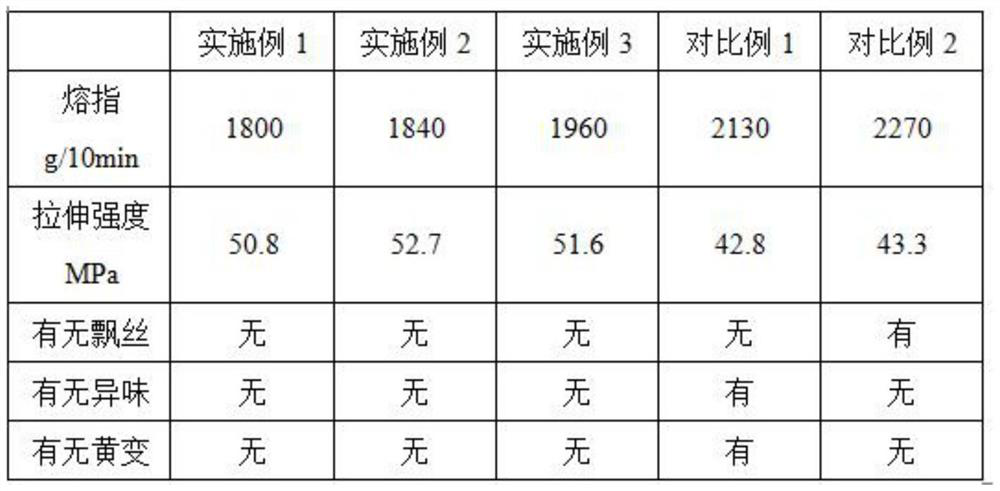Production process of high-melt-index polypropylene melt-blown material
A polypropylene melt-blown and production process technology, which is applied in the production process of high-melt polypropylene melt-blown materials, can solve problems such as process instability, non-woven odor, additive loss, etc., and achieve good melt fluidity, No odor and yellowing, and the effect of stabilizing the degradation rate
- Summary
- Abstract
- Description
- Claims
- Application Information
AI Technical Summary
Problems solved by technology
Method used
Image
Examples
Embodiment 1
[0022] A production process for high melting point polypropylene melt-blown material, comprising the following steps:
[0023] a) Mix the polypropylene powder with the peroxide composite degradation agent, the amount of the polypropylene powder and the peroxide composite degradation agent added is calculated in parts by mass: 80 parts and 5 parts of the polypropylene powder, and the peroxide composite degradation The agent is mixed with dicumyl peroxide and phenol hydroxylase, the mass ratio of the dicumyl peroxide and phenol hydroxylase is 12:1, added in the twin-screw extruder, then added additives and mixed evenly, Additives are high temperature resistant stabilizer and lubricant, in parts by mass: 5 parts of high temperature resistant stabilizer, 2 parts of lubricant, react in the screw reaction section of twin-screw extruder, carry out melt extrusion, melting temperature is 270 ℃, and at the end of the screw of the twin-screw extruder, add a long-acting stabilizer and a s...
Embodiment 2
[0026] A production process for high melting point polypropylene melt-blown material, comprising the following steps:
[0027] a) Mix the polypropylene powder with the peroxide composite degradation agent, the amount of the polypropylene powder and the peroxide composite degradation agent added is calculated in parts by mass: 50 parts and 2 parts of the polypropylene powder, and the peroxide composite degradation agent The agent is mixed with dicumyl peroxide and phenol hydroxylase, the mass ratio of the dicumyl peroxide and phenol hydroxylase is 10:1, added in the twin-screw extruder, then added additives and mixed evenly, The additives are high temperature resistant stabilizer and lubricant, in parts by mass: 2 parts of high temperature resistant stabilizer and 1 part of lubricant, react in the screw reaction section of the twin-screw extruder, and carry out melt extrusion with a melting temperature of 250 ℃, and at the end of the screw of the twin-screw extruder, add a long...
Embodiment 3
[0030] A production process for high melting point polypropylene melt-blown material, comprising the following steps:
[0031] a) Mix the polypropylene powder with the peroxide composite degradation agent, the amount of the polypropylene powder and the peroxide composite degradation agent added is calculated in parts by mass: 100 parts and 10 parts of the polypropylene powder, and the peroxide composite degradation The agent is mixed with dicumyl peroxide and phenol hydroxylase, the mass ratio of the dicumyl peroxide and phenol hydroxylase is 15:1, added in the twin-screw extruder, then added additives and mixed evenly, Additives are high temperature resistant stabilizer and lubricant, in parts by mass: 4 parts of high temperature resistant stabilizer, 3 parts of lubricant, react in the screw reaction section of twin-screw extruder, carry out melt extrusion, melting temperature is 260 ℃, and at the end of the screw of the twin-screw extruder, add a long-acting stabilizer and a...
PUM
 Login to View More
Login to View More Abstract
Description
Claims
Application Information
 Login to View More
Login to View More - R&D
- Intellectual Property
- Life Sciences
- Materials
- Tech Scout
- Unparalleled Data Quality
- Higher Quality Content
- 60% Fewer Hallucinations
Browse by: Latest US Patents, China's latest patents, Technical Efficacy Thesaurus, Application Domain, Technology Topic, Popular Technical Reports.
© 2025 PatSnap. All rights reserved.Legal|Privacy policy|Modern Slavery Act Transparency Statement|Sitemap|About US| Contact US: help@patsnap.com

